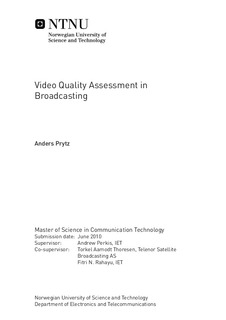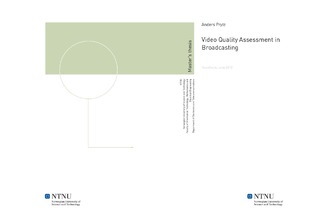| dc.contributor.advisor | Perkis, Andrew | nb_NO |
| dc.contributor.author | Prytz, Anders | nb_NO |
| dc.date.accessioned | 2014-12-19T13:45:44Z | |
| dc.date.accessioned | 2015-12-22T11:44:06Z | |
| dc.date.available | 2014-12-19T13:45:44Z | |
| dc.date.available | 2015-12-22T11:44:06Z | |
| dc.date.created | 2010-09-21 | nb_NO |
| dc.date.issued | 2010 | nb_NO |
| dc.identifier | 352520 | nb_NO |
| dc.identifier.uri | http://hdl.handle.net/11250/2369976 | |
| dc.description.abstract | In broadcasting, the assessment of video quality is mostly done by a group of highly experienced people. This is a time consuming task and demands lot of resources. In this thesis the goal is to investigate the possibility to assess perceived video quality with the use of objective quality assessment methods. The work is done in collaboration with Telenor Satellite Broadcasting AS, to improve their quality verification process from a broadcasting perspective. The material used is from the SVT Fairytale tape and a tape from the Norwegian cup final in football 2009. All material is in the native resolution of 1080i and is encoded in the H.264/AVC format. All chosen compression settings are more or less used in daily broadcasting. A subjective video quality assessment been carried out to create a comparison basis of perceived quality. The subjective assessment sessions carried out by following ITU recommendations. Telenor SBc provided a video quality analysing system, the Video Clarity Clearview system that contains the objective PSNR, DMOS and JND. DMOS and JND are two pseudo-subjective assessment methods that use objective methods mapped to subjective results. The methods hopefully predict the perceived quality and eases quality assessment in broadcasting. The correlation between the subjective and objective results is tested with linear, exponential and polynomial fitting functions. The correlation for the different methods did not achieve a result that proved use of objective methods to assess perceived quality, independent of content. The best correlation result is 0.75 for the objective DMOS method. The analysis shows that there are possible dependencies in the relationship between subjective and objective results. By measuring spatial and temporal information possible dependent correlation results are investigated. The results for dependent relationships between subjective and objective results are good. There are some indications that the two pseudo-subjective methods, JND and DMOS, can be used to assess perceived video quality. This applies when the mapping functions are dependent on spatial and temporal information of the reference sequences. The correlation achieved for dependent fitting functions, that has a suitable progression, are in the range 0.9 -- 0.98. In the subjective tests, the subjects used were non-experts in quality evaluation. Some of the results indicate that subjects might have a problem with assessing sequences with high spatial information. This thesis creates a basis for further research on the use of objective methods to assess the perceived quality. | nb_NO |
| dc.language | eng | nb_NO |
| dc.publisher | Institutt for elektronikk og telekommunikasjon | nb_NO |
| dc.subject | ntnudaim | no_NO |
| dc.title | Video Quality Assessment in Broadcasting | nb_NO |
| dc.type | Master thesis | nb_NO |
| dc.source.pagenumber | 107 | nb_NO |
| dc.contributor.department | Norges teknisk-naturvitenskapelige universitet, Fakultet for informasjonsteknologi, matematikk og elektroteknikk, Institutt for elektronikk og telekommunikasjon | nb_NO |

